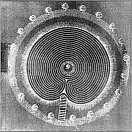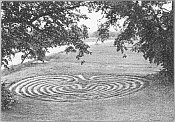
Translated from Germanien, 1936, pages 83–86.
This translation, and a translation of Mössinger’s article, were published together as Troytowns in Germany, IGR Occasional Paper No. 10, Bar Hill, Cambridge, 1978.
Figure 1 is both printed in negative and reversed (cf. the same plan in Mössinger).
{1}
A TROYTOWN IN POMERANIA
The essay by Haye Hamkens (Germanien 1934, No. 12, p. 359 ff) leaves out one of the most important German Troytowns: the one at Stolp in Pomerania. The reason why this has till now escaped researchers like Ernst Krause, Paul Liebeskind, H. Wiechel and E. Schnippel is perhaps because it bears the unusual name of Windelbahn (coil-track), and because there neither peasants nor crusaders, as on the Prussian “Jerusalem hills”, but simple shoemakers performed their characteristic dance. After the last Windelbahn festival was held there in 1908, the town bought up the site, which till then had belonged to the shoemakers’ guild, and had the costumes, tools, and the old groundplan of the dance-path brought into the museum.
The Windelbahn festival of the Stolp shoemakers was a genuine May festival, for it began on the Tuesday after Whitsun and also, in common with other German Whitsuntide events, included the election of a May king. Not only the sons of the upper classes, but manual workers too exercised this springtime privilege of young people in North German towns. In the morning two lads, dressed up as jesters in antique style, begged gifts for the festival; then in the afternoon there followed the solemn procession of the guild with their banners. Alongside them marched two standard-bearers, behind these came the May king with the two treasurers of the guild, then the two elected senior and junior stewards, then the guild members, a so-called clerk, and lastly, in litters carried by the apprentices, the two jesters.
The costumes and the display of craftsmen’s badges will not be gone into here. They conform to the usual practice
in guild and corporation festivals. More important is the layout of the Windelbahn, to which the procession marched.

Fig. 1
At the crossing of the roads later known as Auckerstrasse and Bütowerstrasse the guild members had built a low bank,
about 120 paces in circumference, and on top had planted trees at suitable intervals. Within the bank the pattern was
inscribed in the turf some 150 feet in diameter, no doubt starting in the middle. There were created labyrinthine,
skillfully curved lines, like those on a Bronze Age brooch which come together and then move apart again, They produced
eight tracks on each side, giving the appearance of the curves that symbolize the Sun’s course in old
representations. A Swedish Yule loaf, with a swastika in its original form, that was on show at the religious history
exhibition in Berlin in 1933, likewise shows these solar curves. On the other hand they are represented on an Iron Age
spindle-whorl from Hohenwutzow near Königsberg by the old eight-pointed symbol. Such a sign was also to be found in
the branches of the Mervigslinde lime-tree near Nordhausen, and it is significant that every year the shoemakers’
guild of Nordhausen organized a ceremonial procession to this tree.
On arriving at the Windelbahn, the Stolp shoemakers set up their banners. Then the May king made a speech in verse and afterwards began his dance with a “lapwing step” along the path, which was strewn with fresh flowers or sand. (The lapwing jumps about a metre forwards, stands on one foot, and slightly raises the other.) After about a quarter of an hour the May king had danced along half the paths and paused. Immediately the oldest member presented him with a goblet, which he drained to the cheers of the crowd. Then the dance continued in the same way, till the dancer reached the end of the path and stepped out. After him danced the two senior stewards. One began his dance from the inside, the other from the outside, In the middle they met, greeted each other, and drank from glasses brought by the oldest member, Then they withdrew from each other along the path they had just taken. It was not easy {2} to extricate oneself from the complicated turnings, and anyone who went along the wrong path or could not find the exit was heartily laughed at. After further speeches the two jesters stepped forward to amuse the audience with traditional shoemakers’ jokes. After a solemn procession round the Windelbahn everyone went to the ball in the public house.

Fig. 2
The essentials at the Windelbahn festival are not the entertainments customary at that time, such as the speeches,
drinking, procession, and ball; these are additions due to later development and derive from the holiday customs of the
manual workers. The banners set up on the path, and the performance by the jesters, already belong to ancient layers of
folklore. But what is unique is the layout of the dance path and the obviously very ancient dance step; here called the
lapwing step, after the characteristic hopping. In Crete it is called the crane dance. Now this step gives fresh
significance to the preservation (not mentioned by Hamkens) of our ancestors’ May festival in the skipping-game
played every year by children in springtime, and known as Paradise game, Heaven and Hell, Himmelhuppe, etc. Even before
World War I H. Wiechel had carefully investigated this game in Saxony and had pointed out its connexion with
Troytowns. Subsequently E. Schnippel recognized the connexion between the East Prussian “Jerusalem
hills” and the children’s springtime game. During the war I was able to establish the distribution of this
game over the Balkan peninsula. Further, the children’s skipping festival at Kaufbeuren and the
“Schlangenziehen” at the Naumburg church festival were brought into consideration, Finally recent research
into the sword dance (by Kurt Meschke) has indicated that “… between the interlaced ribbon or animal
ornament of the folk-migration period, and the sword dance, there is a striking coincidence of style …”.
“Closing quote missing in the originalThe
dance is a twisting and unravelling, a perpetual weaving of lines. Only the end of this continuous interlacing is
particularly emphasized, and acquires a mimic content – which appears to be the real purpose of this pattern
– as the main focus, towards which and around which the lines are winding. Sword-dance figures and the pattern of
lines in the Windelbahn belong to a single creative impulse. They are Germanic. Perhaps in further research into the
sword dances so important for understanding the early Germanic period, the Troytowns and in particular the Windelbahn at
Stolp can be taken into account. Sword dances were in fact practised very enthusiastically in the workmen’s guilds
of German towns; as was the Windelbahn festival by the young shoemakers here. Incidentally the morris dance mentioned by
Hamkens was frequently presented by craftsmen under the name Mohrentanz; I cite here a “Morischkotanz” in
Nuremberg in 1479, a morris dance in Eger, and the presentation of a morris dance by the tailors of Strasbourg in 1538.
It is also reported from Winterthur, Zürich, Berne, Frankfurt am Main, and Danzig (as late as 1698). Further, this
morris dance is related to the “Schemenlaufen” at Imst and the hobby horse of English dancers at Christmas.
Thus it belongs to the sphere of ritual. In later times the strong awareness of this dance’s archaic nature is
shown by the fact that the Stolp shoemakers explained their festival as the foundation of a certain Prince Kroy, just as
in Kaufbeuren Gustavus Adolphus of Sweden is supposed to be the founder of the children’s festival.
Thus the Windelbahn festival at Stolp shows that even in the context cf urban handicrafts the old traditional customs were operative for a long time. For Stolp however an ancient solar sanctuary can be assumed.